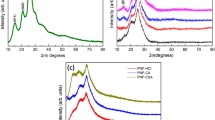Abstract
Conducting polymers are difficult to process, since unlike conventional polymers, they generally do not dissolve in common solvents or melt. By synthesizing nanostructured forms of the conjugated polymer polyaniline, simple methods for making conducting polymer inks become possible. By using either interfacial polymerization or a rapid-mixing technique, nanostructured polyaniline has been synthesized in a readily scalable process. Polyaniline nanofibers make excellent sensors for acids and bases. When decorated with metal nanoparticles, they can be used for molecular memory devices and catalysis. Using a flash from a camera, polyaniline nanofibers can be melted and patterned to make sensors, actuators, and asymmetric membranes. Single crystals of tetraaniline can be grown that exhibit conductivities approaching that of the bulk polymer.





Similar content being viewed by others
References
R.B. Kaner, A.G. MacDiarmid, Sci. Am. 258, 106 (1988).
http://www.nobelprize.org/nobel_prizes/chemistry/laureates/2000.
C. Wu, T. Bein, Science 264, 1757 (1994).
C.R. Martin, Acc. Chem. Res. 28, 61 (1995).
H. Qiu, M. Wan, Macromolecules 34, 675 (2001).
I.D. Norris, M.M. Shaker, F.K. Ko, A.G. MacDiarmid, Synth. Met. 114, 109 (2000).
J. Huang, S. Virji, B.H. Weiller, R.B. Kaner, J. Am. Chem. Soc. 125, 314 (2003).
J. Huang, R.B. Kaner, J. Am. Chem. Soc. 126, 851 (2004).
J. Huang, R.B. Kaner, Chem. Commun. 4, 367 (2006).
J. Huang, R.B. Kaner, Angew. Chem. Int. Ed. 43, 5817 (2004).
B.T. McVerry, J.A.T. Temple, X. Huang, K.L. Marsh, E.M.V. Hoek, R.B. Kaner, Chem. Mater. 25, 3597 (2013).
G.R. Guillen, T.P. Farrell, R.B. Kaner, E.M.V. Hoek, J. Mater. Chem. 20, 4621 (2010).
D. Li, R.B. Kaner, Chem. Commun. 26, 3286 (2005).
D. Li, R.B. Kaner, J. Mater. Chem. 17, 2279 (2007).
J.M. D’Arcy, H.D. Tran, V.C. Tung, A.K. Tucker-Schwartz, Y. Yang, R.B. Kaner, Proc. Natl. Acad. Sci. U.S.A. 107, 19673 (2010).
J.M. D’Arcy, H.D. Tran, A.Z. Stieg, J. Gimzewski, R.B. Kaner, Nanoscale 4, 3075 (2012).
J. Huang, S. Virji, B. Weiller, R.B. Kaner, Chem. Eur. J. 10, 1314 (2004).
S. Virji, J. Huang, R.B. Kaner, B.H. Weiller, Nano Lett. 4, 591 (2004).
S. Virji, B.H. Weiller, J. Huang, R. Blair, H. Shepherd, T. Faltens, P.C. Haussmann, R.B. Kaner, S.H. Tolbert, J. Chem. Educ. 85, 1102 (2008).
S. Virji, J.D. Fowler, C.O. Baker, J. Huang, R.B. Kaner, B.H. Weiller, Small 1, 624 (2005).
S. Virji, R. Kojima, J.D. Fowler, J.G. Villanueva, R.B. Kaner, B.H. Weiller, Nano Res. 2, 135 (2009).
S. Virji, R. Kojima, J. Fowler, R.B. Kaner, B.H. Weiller, Chem. Mater. 21, 3056 (2009).
S. Virji, R.B. Kaner, B.H. Weiller, Chem. Mater. 17, 1256 (2005).
R.J. Tseng, J. Huang, J. Ouyang, R.B. Kaner, Y. Yang, Nano Lett. 5, 1077 (2005).
R.J. Tseng, C.O. Baker, B. Shedd, J. Huang, J. Ouyang, R.B. Kaner, Y. Yang, Appl. Phys. Lett. 90, 053101 (2007).
B.J. Gallon, R.W. Kojima, R.B. Kaner, P.L. Diaconescu, Angew. Chem. Int. Ed. 46, 7251 (2007).
J. Huang, R.B. Kaner, Nat. Mater. 3, 783 (2004).
V. Strong, Y. Wang, A. Patatanyan, P.G. Whitten, G.M. Spinks, G.G. Wallace, R.B. Kaner, Nano Lett. 11, 3128 (2011).
C.O. Baker, B. Shedd, P.C. Innis, P.G. Whitten, G.M. Spinks, G.G. Wallace, R.B. Kaner, Adv. Mater. 20, 155 (2008).
D. Li, J. Huang, R.B. Kaner, Acc. Chem. Res. 42, 135 (2009).
H.D. Tran, R.B. Kaner, Chem. Commun. 37, 3915 (2006).
H.D. Tran, I. Norris, J.M. D’Arcy, H. Tsang, Y. Wang, B.R. Mattes, R.B. Kaner, Macromolecules 41, 7405 (2008).
Y. Wang, H.D. Tran, R.B. Kaner, J. Phys. Chem. C 113, 10346 (2009).
H.D. Tran, W.G. Hong, J.M. D’Arcy, R.W. Kojima, B.H. Weiller, K. Shin, R.B. Kaner, Macromol. Rapid Commun. 28, 2293 (2007).
Y. Wang, H.D. Tran, L. Liao, X. Duan, R.B. Kaner, J. Am. Chem. Soc. 132, 10365 (2010).
Y. Wang, J. Liu, H.D. Tran, M. Mecklenburg, X.N. Guan, A.Z. Stieg, B.C. Regan, D.C. Martin, R.B. Kaner, J. Am. Chem. Soc. 134, 9251 (2012).
Q.H. Wang, M.C. Hersam, Nat. Chem. 1, 206 (2009).
Y. Wang, J.A. Torres, A.Z. Stieg, S. Jiang, M.T. Yeung, Y. Rubin, S. Chaudhuri, X. Duan, R.B. Kaner, ACS Nano 9, 9486 (2015).
J.M. D’Arcy, M.F. El-Kady, P.P. Khine, L. Zhang, S.H. Lee, N.R. Davis, D.S. Liu, M.T. Yeung, S.Y. Kim, C.L. Turner, A.T. Lech, P.T. Hammond, R.B. Kaner, ACS Nano 8, 1500 (2014).
Acknowledgements
The author thanks J. Huang, S. Virji, R. Blair, D. Li, H. Tran, K. Shin, C. Baker, B. Shedd, V. Strong, R. Kojima, J. D’Arcy, Y.(J.) Wang, B. McVerry, Y. Liao, T. Farrell, K. Marsh, X.(W.) Huang, B. Weiller, G. Wallace, G. Spinks, D. Martin, Y. Yang, P. Diaconescu, E. Hoek, and S. Tolbert for their contributions. He also thanks their sponsors, including the National Science Foundation, the Microelectronics Advanced Research Corp., Homeland Security Advanced Research Projects Agency, Abraxis Bioscience, Boeing, and Water Planet.
Author information
Authors and Affiliations
Corresponding author
Additional information
The following article is based on the MRS Medal presentation given by Richard B. Kaner at the 2015 MRS Fall Meeting in Boston. He is cited “for the discovery of efficient methods to synthesize water-dispersible conducting polymer nanofibers and their applications in sensors, actuators, molecular memory devices, catalysis, and the novel process of flash welding.”
Rights and permissions
About this article
Cite this article
Kaner, R.B. Synthesis and applications of conducting polymer nanofibers. MRS Bulletin 41, 785–790 (2016). https://doi.org/10.1557/mrs.2016.213
Published:
Issue Date:
DOI: https://doi.org/10.1557/mrs.2016.213




